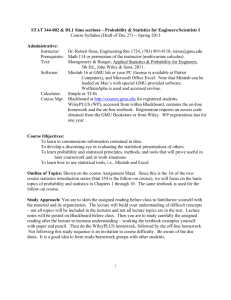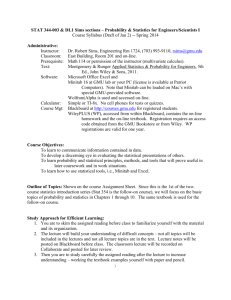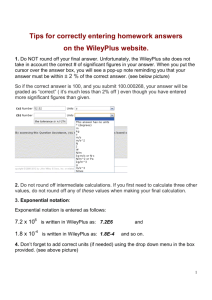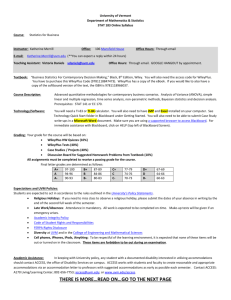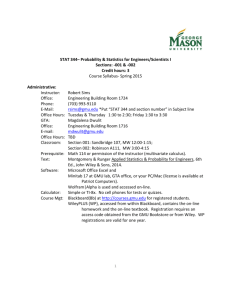STAT 350-001 -- Introductory Statistics II Course Syllabus (Draft of
advertisement
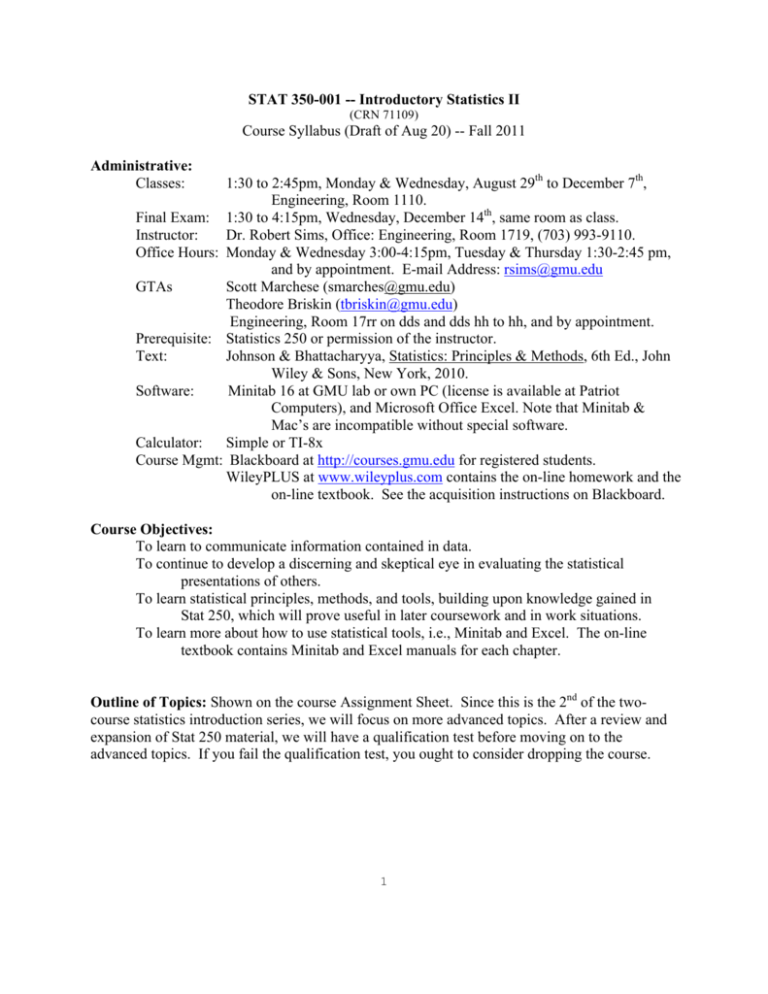
STAT 350-001 -- Introductory Statistics II (CRN 71109) Course Syllabus (Draft of Aug 20) -- Fall 2011 Administrative: Classes: 1:30 to 2:45pm, Monday & Wednesday, August 29th to December 7th, Engineering, Room 1110. Final Exam: 1:30 to 4:15pm, Wednesday, December 14th, same room as class. Instructor: Dr. Robert Sims, Office: Engineering, Room 1719, (703) 993-9110. Office Hours: Monday & Wednesday 3:00-4:15pm, Tuesday & Thursday 1:30-2:45 pm, and by appointment. E-mail Address: rsims@gmu.edu GTAs Scott Marchese (smarches@gmu.edu) Theodore Briskin (tbriskin@gmu.edu) Engineering, Room 17rr on dds and dds hh to hh, and by appointment. Prerequisite: Statistics 250 or permission of the instructor. Text: Johnson & Bhattacharyya, Statistics: Principles & Methods, 6th Ed., John Wiley & Sons, New York, 2010. Software: Minitab 16 at GMU lab or own PC (license is available at Patriot Computers), and Microsoft Office Excel. Note that Minitab & Mac’s are incompatible without special software. Calculator: Simple or TI-8x Course Mgmt: Blackboard at http://courses.gmu.edu for registered students. WileyPLUS at www.wileyplus.com contains the on-line homework and the on-line textbook. See the acquisition instructions on Blackboard. Course Objectives: To learn to communicate information contained in data. To continue to develop a discerning and skeptical eye in evaluating the statistical presentations of others. To learn statistical principles, methods, and tools, building upon knowledge gained in Stat 250, which will prove useful in later coursework and in work situations. To learn more about how to use statistical tools, i.e., Minitab and Excel. The on-line textbook contains Minitab and Excel manuals for each chapter. Outline of Topics: Shown on the course Assignment Sheet. Since this is the 2nd of the twocourse statistics introduction series, we will focus on more advanced topics. After a review and expansion of Stat 250 material, we will have a qualification test before moving on to the advanced topics. If you fail the qualification test, you ought to consider dropping the course. 1 Study Approach: You are to skim the assigned reading before class to familiarize yourself with the material and its organization. The lecture will build your understanding of difficult concepts – not all assigned text topics will be included in the lectures and not all lecture topics are in the text. My lecture notes will be posted on Blackboard. Then you are to study carefully the assigned reading after the lecture to increase understanding – working the text examples yourself with paper and pencil. Then do the WileyPLUS homework, followed by the off-line homework. Not following this study sequence is an invitation to course difficulty. Be aware of the due dates. It is a good idea to form study/homework groups with other students. Class: Class participation is encouraged to help the overall class to better understand the material through student interaction. A lot of student/instructor interaction is expected. Certain topics, not in the textbook, will be covered in class and tested. Homework Assignments: There is both on-line and off-line homework as shown on the course Assignment Sheet. The on-line homework is accomplished on WileyPLUS, similar to the StatsPortal system used in Stat 250. On average, there are about 20 questions due weekly. Only three attempts to get the correct answer are allowed. Some questions change data sets between attempts and may be different from the published data sets. Numerical answers are sensitive to accuracy and significance. Use Excel and Minitab to organize data and to obtain absolutely correct answers. Your performance on the on-line questions is recorded on the WileyPLUS gradebook. Be aware of the due dates -- late homework is penalized at 50%. Your first assignment on WileyPLUS is Assignment Zero -- it serves to familiarize you with the WileyPLUS features and is graded. The off-line homework is shown on the course Assignment Sheet posted on Blackboard. Do your assignments in Minitab, Word, and/or Excel using the format shown on Blackboard. Answers must be supported and shown to the proper level of accuracy. Data sets for homework problems and Minitab guidance are available at the textbook publisher’s student companion website here. Manual work will not be accepted. Be aware that the answers in the back of the book are not always correct or precise. Your attractively formatted and printed homework assignments are to be handed in at the beginning of the Monday (Sec 001) class. Late homework, without prior permission, will be penalized 50% if turned in within the week – later submissions will not be accepted. If you must be absent, submit your homework on time via a classmate or by properly formatted email. Routine submission of homework by email will not be accepted – I am not your printing service. During the week following the due date, homework (graded by the GTA) will be returned and homework solutions will be reviewed in class. In addition to the assigned turn-in problems, the conscientious student will work many additional problems. Practice makes perfect! Statistics Project: The purpose of the project is to put theory into practice. Two-person teams will be appointed by Dr. Sims. The team will select a problem amenable to statistical analysis, choose an analysis approach, gather primary data, analyze the data and reach some conclusion. Then the team will write a paper of about three pages explaining their work with mathematics and graphical displays. A grading rubric will be provided. 2 Quizzes and Exams: All quizzes and exams will be closed book, closed notes, open formula sheet and tables; and I generally grade them. Your personally-created study guide/formula sheet is intended to eliminate the need to memorize formulas, but may contain anything. Quiz and exam questions will be generally drawn from the textbook's questions. Therefore, in a theoretical sense, the student has a legal advance copy of the quizzes and the exams! There is no “extra credit” or forgiven grades – you are responsible for all of your work done (or left undone). If a quiz or exam is scheduled on a religious holiday that you observe, see me to make alternative arrangements. If you have a disability that requires academic accommodation, contact the Office of Disability Services (993-2474) for authorization. Honor Code: I take the GMU Honor Code very seriously and will enforce it – don’t make a mistake! Other people’s work, with your name on it, is a violation. Grading Scheme: Homework Quizzes (3) Project 30% 15% 5% Qualification Exam Midterm Exam Final Exam Total 15% 15% 20% 100% I maintain an open grade book on Blackboard – you can check your running grade at any time so there are no surprises. In fact, I ask you to audit my correct entry of your grades. No grade corrections will be made after the last class of the semester. Course letter grades are assigned as follows and are not curved: 90 – 100 points 80 – 89 points 70 – 79 points 60 – 69 points 0 – 59 points A B C D F 3
